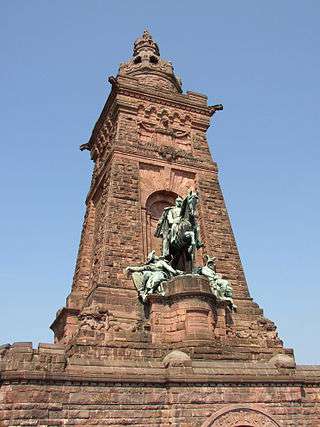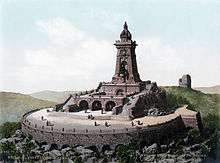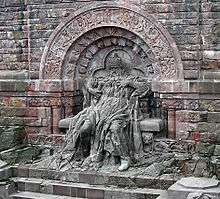Kyffhäuser Monument

The Kyffhäuser Monument (German: Kyffhäuserdenkmal), also known as Barbarossa Monument (Barbarossadenkmal), is an Emperor William monument within the Kyffhäuser mountain range in the German state of Thuringia. It was erected in 1890–96 at the site of medieval Kyffhausen Castle near Bad Frankenhausen.
The Kyffhäuser Monument is the third-largest monument in Germany, after the Monument to the Battle of the Nations (Völkerschlachtdenkmal) commemorating the 1813 Battle of Leipzig and the Emperor William Monument at Porta Westfalica, both of which also were designed by architect Bruno Schmitz (1858–1916).
Geography
The monument, which totals 81 metres (266 ft) tall, is located in the eastern part of the Kyffhäuser range at an elevation of c. 420 m (1,380 ft) below the Kyffhäuserburgberg peak, 439.7 m (1,443 ft). The site belongs to Steinthaleben in the municipal area of Kyffhäuserland, about 6.5 kilometres (4.0 mi) north of Bad Frankenhausen and southwest of Tilleda in the Goldene Aue plain.
History

After the death of William I (Wilhelm I.), first German Emperor in 1888, numerous memorials were erected in his honour all over the German Empire. The Kyffhäuser Monument was initially proposed by the 19th century Deutscher Kriegerbund (German War Veterans Federation), which under the name Kyffhäuserbund (Kyffhäuser Federation) took over its maintenance after 1900. Architect Bruno Schmitz drew up plans referring to the tradition of massive monuments like the Bavarian Walhalla memorial, the Hermannsdenkmal in the Teutoburg Forest, or the Niederwalddenkmal near Rüdesheim.
The monument was built atop the ruins of the medieval Imperial castle of Kyffhausen, a German Baron. Stylistically, it recalls the castles and fortresses of the Hohenstaufen era in Germany in the 12th and 13th centuries. In the beginning period of Wilhelminism, it was intended to suggest that the Prussia-dominated German Empire founded in 1871 was the legitimate successor to the medieval Holy Roman Empire. It also signifies the national theme of decline and rebirth.

The monument features a 6.5-metre-tall (21 ft) sandstone figure of the Hohenstaufen emperor Frederick Barbarossa ("The Red-Bearded") by Nikolaus Geiger (1849–1897). Referring to the king in the mountain legend of Barbarossa, which held that the emperor was sleeping under the Kyffhäuser Mountain and someday would rise again when Germany needed his leadership, the sculpture appears to just have awakened. Above him stands an 11-metre-tall (36 ft) copper equestrian statue of Emperor William I, designed by sculptor Emil Hundrieser (1846–1911) in a Neo-baroque style. This composition expresses the monument's theme: That William I brought to fruition the unification of the German nation that had been so long desired since Barbarossa's time.
Towering over the monument is a 57-metre (187 ft) tower topped by a huge imperial crown. A 247-step stairway leads to the top of the tower, offering a panoramic view over the Kyffhäuser range to the Harz mountains in the north and down to the Thuringian Forest in the south. An adjacent building features exhibits depicting medieval Kyffhausen Castle and the Barbarossa legend.
Further reading
- Gunther Mai: Das Kyffhäuser-Denkmal 1896-1996; Böhlau Verlag; 1997; ISBN 3-412-02397-3
- Rudy Koshar: From Monuments to Traces: Artifacts of German Memory, 1870-1990; University of California Press, 2000; ISBN 0-520-21768-3.
External links
| Wikimedia Commons has media related to Kyffhäuser and Kyffhäuserdenkmal. |
- Official website by the Kyffhäuser Tourist Association
- Kyffhäuserdenkmal (German)
Coordinates: 51°24′47″N 11°06′35″E / 51.41306°N 11.10972°E